April 2024 Mailbag No 2

Out first item comes from D the Roving Reporter in Central Victoria - and it is from way back in time and something for fans of the sculptor Ola Cohn an artist we have written several posts on. D has found a newspaper clipping describing an exhibition Ola had when an art student...
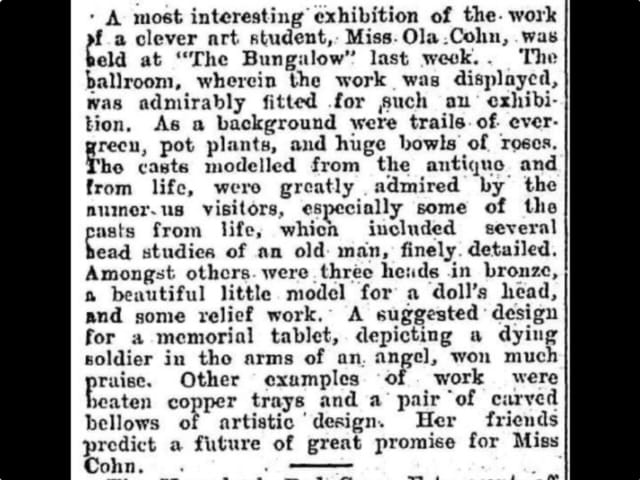
Still in Australia we now journey up to the glorious Hunter Valley where AnArt4Life team member Andrew has purchased a new painting which we want to showcase. Andrew's new painting is by Terence John Santry Australia, 1910-1990.
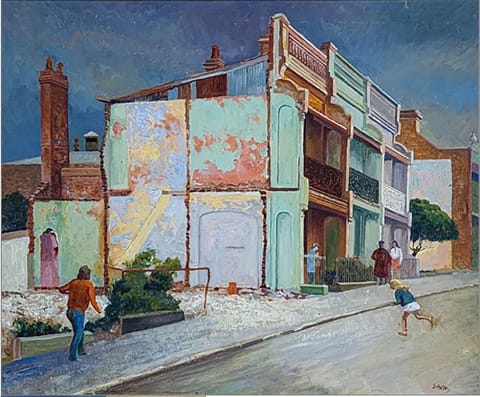
Terence John Santry (1910-1990) was a distinguished Australian artist whose work left an indelible mark on the Australian art scene. Born in 1910, Santry's artistic journey began with a fascination for capturing the essence of the Australian landscape and its unique light. His paintings often depicted sweeping vistas of the Outback, vibrant coastal scenes, and the lush greenery of the bush, showcasing his deep connection to the natural world. Santry's mastery lay in his ability to infuse his canvases with a sense of tranquility and introspection, inviting viewers to immerse themselves in the beauty of the Australian environment. Throughout his career, he experimented with various styles and techniques, but it was his use of color and light that truly set his work apart. Today, Terence John Santry's legacy endures through his timeless artworks, which continue to captivate audiences and evoke a sense of wonderment for the Australian landscape. 1
Monica in Tanzania has sent in another book recommendation: Thinking About Art by Penny Huntsman.
"Thinking About Art" by Penny Huntsman is a seminal text that serves as a comprehensive guide to understanding and appreciating art. Through meticulous analysis and insightful commentary, Huntsman navigates readers through the complex and multifaceted world of art, offering a deeper understanding of its various forms, movements, and philosophies. From classical masterpieces to contemporary installations, Huntsman explores the evolution of art throughout history, examining the cultural, social, and political contexts that have shaped artistic expression. With clarity and eloquence, "Thinking About Art" invites readers to engage critically with artworks, encouraging them to consider the myriad ways in which art reflects and challenges our perceptions of the world. Whether a seasoned art enthusiast or a novice explorer, Huntsman's book offers invaluable insights that will enrich one's understanding and appreciation of the visual arts.1
Here is an excerpt from the book:
Though they had been around for centuries, oil paints gained prominence and popularity with the masterful works of Jan van Eyck in the 15th century. Acrylic paints emerged as a potential alternative to oil paints for artists in the 1950s:
“Acrylic paint was first used in the 1940s and made commercially available in the 1950s and while it is assumed to have greater durability than oil and a reduced tendency to discolour, its permanency is yet to be tested. Acrylic also dries much faster than oil, and so is less suited to images that require modelling or chiaroscuro. Acrylic paint, which uses an acrylic polymer emulsion as a binder, dries to a flexible paint film because it is comprised of interlocking molecules which shift without causing damage during expansion and contraction. While oil paint is referred to as 'oil-based' on account of its mix with linseed oil, acrylic is referred to as water-based on account of its dilution with water, if desired, although it is most commonly applied thickly to give an opaque finish.
“Acrylic is also quite flat in terms of its light absorption which can render its subject fairly stark in contrast to the light-reflective qualities of oil. Consider Vermeer's View of Delft, 1660-1661, for example; if this work had been executed in acrylic, then the atmosphere, the reflected sparkle, and the richness would all be lost. The Prussian Blue that Van Gogh described as 'heavenly' in the View of Delft, is not even possible in acrylic on account of a chemical incompatibility (De Leeuw, The Letters of Vincent van Gogh, p. 401). Vermeer's renowned depiction of sunlight in some works, and the 'spiritual' glow in others, was achievable through his use of Indian Yellow, an oil paint made from the urine of cows fed upon mango leaves. Conversely, as liberating as the medium of oil was for artists like Vermeer, the acrylic paints exploited in Ofili's contemporary works (examined later in this chapter) are not available in oils. Every material brings its own range of possibilities and limitations.
“Oil paintings are prone to cracking over time, while acrylic paintings maintain a stable surface. This is because the binders (liquids mixed with the pigment) in oil and acrylic paint are different. Oil paint binders, such as linseed oil, dry to an inflexible, weak film that may crack as it expands and contracts with changes in external temperature.2
Next we travel to the United Kingdom where E in London has recently visited the Royal Academy of Arts and saw Tavares Strachan’s monumental sculpture in the Royal Academy Courtyard. The First Supper, 2021-23 is a major new sculpture by acclaimed interdisciplinary artist Tavares Strachan (b. 1979, Nassau, The Bahamas), as part of the exhibition Entangled Pasts: 1768–now: Art, Colonialism and Change which opened in February 2024.3
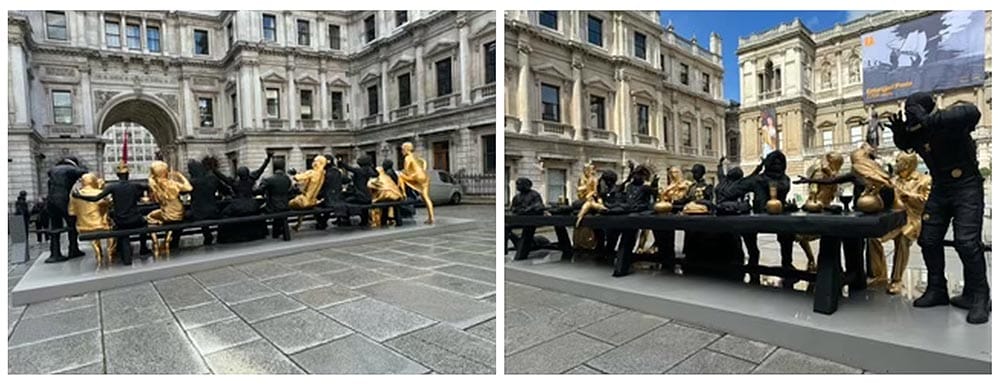
The First Supper represents what Strachan describes as a utopian gathering that brings together historically significant figures from the continent of Africa and its diasporas, accompanied by a thylacine or Tasmanian tiger and a portrait of the artist. It includes sculptural portraits of resistance fighter Zumbi Dos Palmares; nurse Mary Seacole; activists Harriet Tubman, Marcus Garvey, and Marsha P. Johnson; explorer Matthew Henson; astronaut Robert Henry Lawrence; politician Shirley Chisholm; Emperor Haile Selassie; musicians Sister Rosetta Tharpe and King Tubby; and poet Sir Derek Alton Walcott. Although some of the figures around the table are well-known, others have been forgotten and are not widely studied.4
And E in London asks: Did you know that a very early copy of The Last Supper is at the Royal Academy of Arts? I certainly didn't - so let's have a look at it.
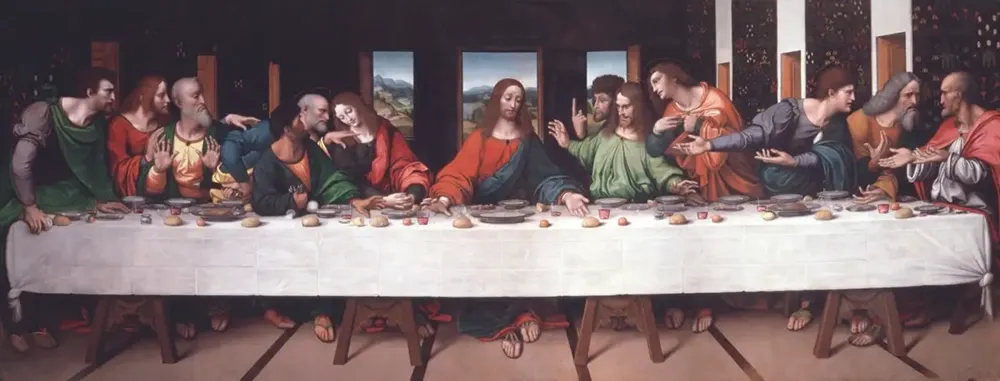
Leonardo's Last Supper (ca. 1495-98) in the refectory of Santa Maria delle Grazie in Milan, was commissioned by his patrons Duke Ludovico Sforza and Beatrice d'Este. The painting represents a scene from the Gospel of John, chapter 13, verse 21, when Jesus announces that one of his Twelve Apostles will betray him. Unlike some earlier depictions of the Last Supper, Leonardo does not give all the apostles halos with the exception of Judas but instead casts Judas' face into shadow to distinguish him from his fellow Apostles.
The Last Supper was executed not in traditional fresco, but in tempera and oil paint on a dry wall. The original has deteriorated very badly as a result of this experimental technique and the dampness of the wall on which it is painted. This early copy (as shown above), possibly painted around 1520, or even as early as 1515 is almost the same size as the original but lacks the top third of Leonardo's composition. It does however shows details that are not now visible in the original, such as the salt-cellar overturned by the right arm of Judas and the feet of Jesus which were lost when another door was inserted in the refectory wall.
Historically the work was attributed to Marco d'Oggiono (c.1467-1524) and this was the artist named linked to the copy when the Royal Academy bought the painting. More recently it has been attributed to Giampietrino, a pupil of Leonardo although there is also the suggestion that Giovanni Antonio Boltraffio (1467-1516) may have worked on this copy as well.
This copy seems to have been privately owned until it was sold to a Carthusian monastery in Pavia in 1591. The copy remained in the monastery until about 1793 when, following the Austrian suppression of the Carthusian monasteries, it was sold. It was then on display in the Brera Academy in Milan for many years before being sent to England in 1817 to be sold.
Many Royal Academicians went to see the copy and were unanimous in their admiration but it took several years before the RA actually bought the painting. According to Henry Fuseli it was 'rescued from a random pilgrimage by the courage and vigilance of our President who was by then Sir Thomas Lawrence.'
The Royal Academy bought this copy for six hundred guineas from an H. Fraville in 1821. This was the most expensive work of art they had ever bought for the Collection. It required all the Academicians being called to a General Assembly meeting to agree the purchase.
The Royal Academicians were delighted with this painting as they were 'of the opinion that the possession of such a work would be of essential benefit to the Schools of the Academy', according to the Council Minutes of 11 June 1821. It was intended as an example for the students to emulate, and in 1825 Henry Fuseli, in his capacity as Professor of Painting, was able to deliver his eleventh lecture in front of this magnificent record of the original glory of Leonardo's now-faded masterpiece.4
If you have time, please follow the bookmark link below to take yourself on a tour around the Royal Academy of Arts, London and be amazed - a wonderful place to visit even if it is virtually!!
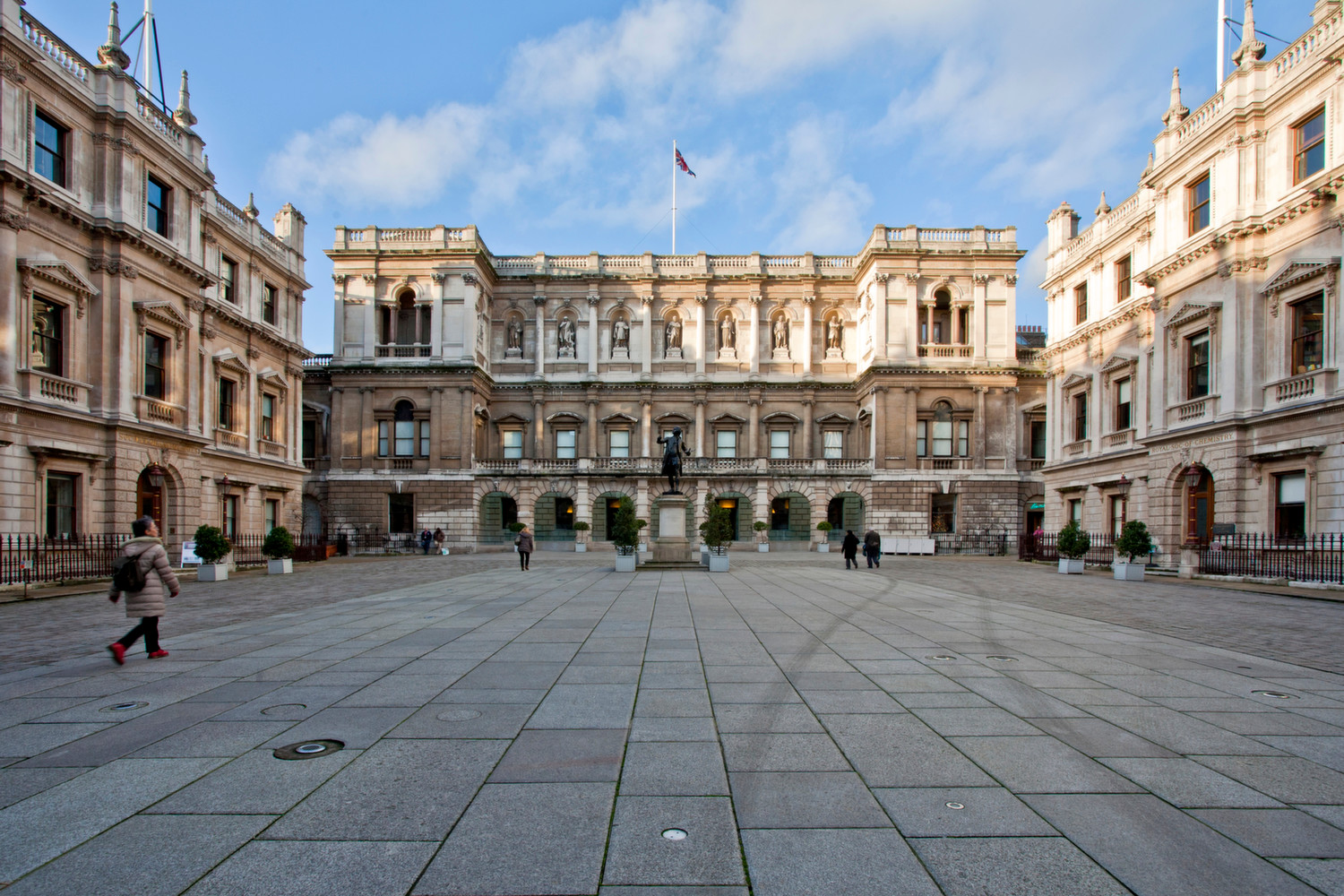
Credit
1. Written by ChatGPT
2. https://delanceyplace.com/view-archives.php?5031
3. https://fadmagazine.com
4. royalacademy.org.uk/article/video-the-first-supper
